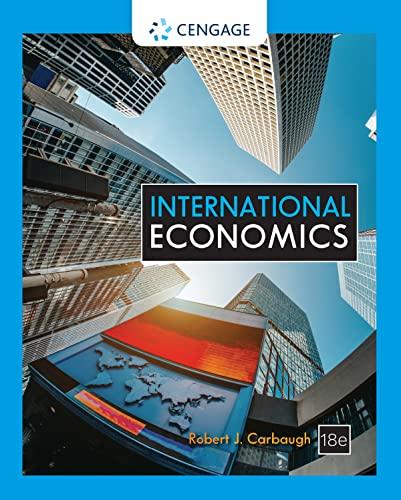Question
1. A complicating factor in international trade is that a. trade between countries requires different currencies rather than one currency. b. gold is used for
1.
A complicating factor in international trade is that
| a. | trade between countries requires different currencies rather than one currency. | |
| b. | gold is used for payments; there are no international payments without gold. | |
| c. | barter is the basis for trade between countries; money is not used. | |
| d. | many other countries prefer to use the U.S. dollar as currency, causing monetary shortage in the United States. |
QUESTION 2
A country that must inhibit imports should give preference to
| a. | quotas over tariffs because quotas are less likely to distort trade patterns between nations. | |
| b. | an embargo wherever possible because an embargo can serve as a political weapon in addition to being a "trade stopper." | |
| c. | export subsidies over quotas or tariffs because export subsidies can protect a nation's domestic producers. | |
| d. | tariffs over quotas because, unlike quotas, tariffs offer no special benefits to inefficient exporters. |
QUESTION 3
A country's comparative advantage can be illustrated by the graph of the production possibilities frontier.
True
False
QUESTION 4
A quota brings a more serious misallocation of resources than a tariff.
True
False
QUESTION 5
A quota specifies the maximum amount of a good that is permitted into the country from abroad per unit of time.
True
False
QUESTION 6
A tariff has one distinct advantage over a quota. It increases tax revenues to the government.
True
False
QUESTION 7
Absolute advantage is a comparison among producers based on productivity.
True
False
QUESTION 8
After the American Civil War, many prominent Southerners lamented the fact that the South "overproduced" cotton and "underproduced" food. In fact, the South did import a very large percentage of its food. Nevertheless, rather than reduce cotton production and grow more food, Southern farmers did the opposite because
| a. | corn was absolutely cheaper to produce in the North. | |
| b. | they were irrational and distraught over the loss of slavery. | |
| c. | the North had a comparative advantage in cotton production. | |
| d. | the South had a comparative advantage in cotton production. |
QUESTION 9
Among the impediments to the international mobility of capital are
| a. | All of the above are correct. | |
| b. | restrictions on foreign ownership. | |
| c. | fear of nationalization or political instability. | |
| d. | fluctuations in exchange rates. |
QUESTION 10
An example of a quota that protects an American industry is the quota on
| a. | tourists entering the country. | |
| b. | purchases of military hardware to foreign dictators. | |
| c. | sugar imports. | |
| d. | All of the above are examples of protective quotas. | |
| e. | sales of oil products to foreign countries. |
QUESTION 11
Any restriction of international trade that is accomplished by a quota can also be accomplished by a tariff.
True
False
QUESTION 12
As a result of pure free trade in a commodity, the
| a. | price of the commodity will be lower in the producing country. | |
| b. | price of the commodity must be the same in all countries. | |
| c. | price of the commodity will be higher in the producing country. | |
| d. | total quantity imported will exceed the total quantity exported. |
QUESTION 13
Assume that a country imposes a tariff in order to gain a price advantage on an item. What is the typical response from the exporting country?
| a. | It seeks greater efficiency in order to offset the tariff. | |
| b. | It accepts the situation and does nothing about it. | |
| c. | It retaliates by imposing tariffs or quotas on items from the other country. | |
| d. | It refuses to sell to the country that imposes the tariff. |
QUESTION 14
Comparative advantage is a comparison among producers based on opportunity cost.
True
False
QUESTION 15
Comparative advantage, not absolute advantage, determines the decision to specialize in production.
True
False
QUESTION 16
Comparing international trade with trade among the different states of the United States shows that
| a. | All of the above are correct. | |
| b. | there is no need to study international trade as a special subject. | |
| c. | the basic reasons for trade are equally applicable within a country or among countries. | |
| d. | the logic of international trade is quite different from that of intranational trade. |
QUESTION 17
Dumping means selling goods in a foreign market at lower prices than those charged in the home market.
True
False
Step by Step Solution
3.41 Rating (154 Votes )
There are 3 Steps involved in it
Step: 1
The detailed answer for the above question is provided below 1 a trade between countries requires different currencies rather than one currency Explanation In international trade countries use differe...
Get Instant Access to Expert-Tailored Solutions
See step-by-step solutions with expert insights and AI powered tools for academic success
Step: 2

Step: 3

Ace Your Homework with AI
Get the answers you need in no time with our AI-driven, step-by-step assistance
Get Started


